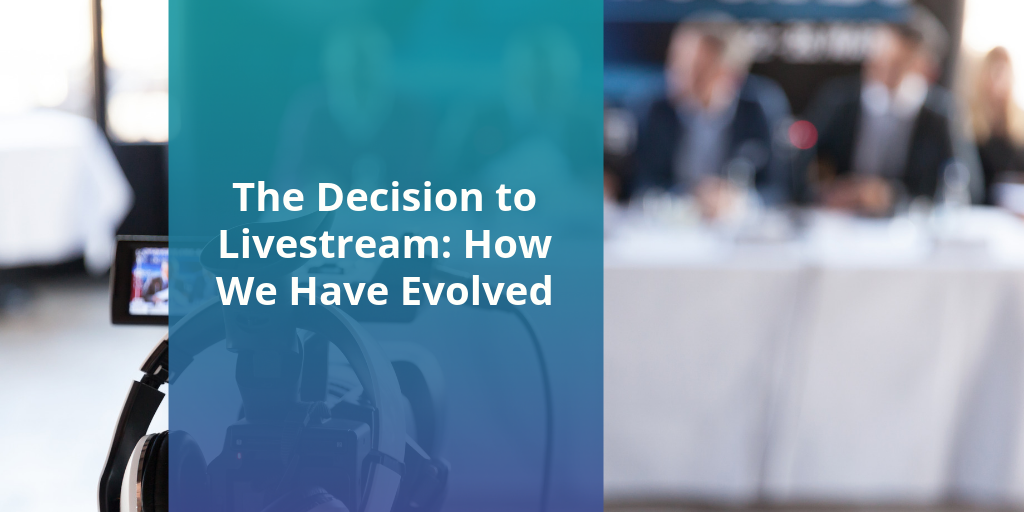
by Rachel Blevins | Aug 27, 2019 | Blog
Ten years ago, CommPartners introduced livestream services with a focus on helping organizations, extend their reach and value of their place based conferences. The rationale at the time was that only a small percentage of our communities are able to attend onsite, leaving a significant number unengaged with these premiere education and networking events. We felt adding a livestream would be positively received. We realized through our initial client conversations, this wasn’t necessarily the case.
One of the reasons for the slow adaption rate was within organization structures, conference and meetings and online education were not always aligned as complementary elements of an education strategy. A livestream presents the intersection of these two areas. Organizations were not internally set to address this new opportunity. Specifically the conference and meetings folks were hesitant to invest in any initiative that might take away from the number of onsite attendees.
Fast forward ten years later, we are seeing significant movement of organizations embracing the chance to increase their audience to more than just the people that attend onsite. So why is this happening now and how can you leverage this opportunity?
We believe there has been a breakthrough for three reasons:
- There is greater recognition that attending online vs. onsite are unique experiences, with different motivations and expectations for participating. The fear of losing onsite attendees to an online offering have not materialized. Alternatively, if presented in the right way, adding a livestream component, will grow the audience and can inspire online attendees to attend onsite for subsequent years.
- Increasingly our members and extended community staffs are working from home full time or several days per week. We are increasingly comfortable managing our work from a distant location and collaborating through our electronic devices.
- Host organizations are realigning how they present content with less focus on how it is originated. The emergence of online education and learning management systems that have become centralized knowledge communities are being used increasingly as central repositories for conference content, virtual events and eLearning programs.
With greater appreciation and emphasis on livestreaming we have become more educated and strategic about how to position, price and deliver these programs. Provided below are considerations and approaches to help you generated positive results from your investment.
Position Your Livestream Programs for Success
We know attending an event remotely, without the energy of a crowd or being at a venue is vastly different than attending alone, through your computer screen. Therefore to have a successful outcome, the planning process should be based on understanding the virtual learner and planning accordingly. Having an alternative or parallel remote participant plan to actively engage online attendees moves them from passive observer to active participant. Ideas include:

- Have programming for just the virtual audience such as pre or post session interviews, pre-produced content, facilitated chats, raffles or giveaways.
- Have an on camera MC for the virtual audience stimulating chats, submitting questions to speakers, and engaging remote attendees.
- Make sure presenters incorporate the virtual audience in their session by looking at the camera, mentioning virtual attendees and having exercises available if the onsite audience is involved in an activity.
- Use a platform that offers engagement features to blend the remote audience with the onsite audience such as live polls, crowdsourcing and contests.
- Ask virtual audience members to upload their picture or groups they are participating with in the collaboration area to give the event a community feel.
- Show a live map of where virtual attendees are logging in from.
Price Your Livestream to Strategically Fit Your Goals
Clients ask us all the time, how should we price our event? Before considering pricing, it’s important to confirm strategy and your reasons for offering the live stream. Some questions you want to consider are:
- What is the value or uniqueness of the content we are providing?
- Are we issuing credit for this program?
- Are the speakers we have well known and would they attract an audience?
- Do we draw onsite attendees from certain geographical areas or level of experience in our community?
- Are we at capacity for our onsite event?
- Are we using the livestream to attract participants to our community or our brand, onboard new members that can’t afford to travel, extend the conference experience, promote attendance for subsequent onsite conferences or a combination of all of all of these?
Based on responses to these questions, you can decide if you want to price your program at a full conference rate similar to the onsite event or attract more online participants with a lower, easy decision rate. In considering revenue goal, sponsorship and / or a virtual exhibit hall can help offset the attendance fees and assure your program meets your budget objectives.

Deliver or Produce Your Livestream in a Professional and Engaging Manner
While education strategy is critical for online events, the production quality will be noticed and is critical to the program’s success. The goal is to have remote attendees feel they are onsite and have a front row seat. We recommend the following:
- Consider a room or multiple rooms to hold all your virtual event sessions that work well as a virtual setting. Think about it as a studio with excellent acoustics, visuals, camera positioning and sound.
- Use your onsite audience to build energy in the program form the virtual audience. Include roving microphones and camera shots to capture audience engagement.
- Use the virtual MC to have a prominent role representing remote participants. Have him or her on camera introducing questions to the speakers.
- Use lower third name graphics to identify who is speaking.
- Consider multiple cameras to switch shots and views.
- Have a remote interview area in a public place that attracts onsite attendees in the audience.
- Consider an eye in the sky mounted camera to cut to transitions to provide the remote audience a sense of the energy at the event.
There appears to be a realization that a livestream is an excellent way to expand an organization’s reach and impact. Providing the opportunity to participate online says to your community that you value their involvement regardless of where they are geographically or what stage in their professional life they may be.
If you are interested in discussing the opportunity for a livestream for your organization, contact Meghan Gowen, VP Client Development at mgowen@commpartners.com.
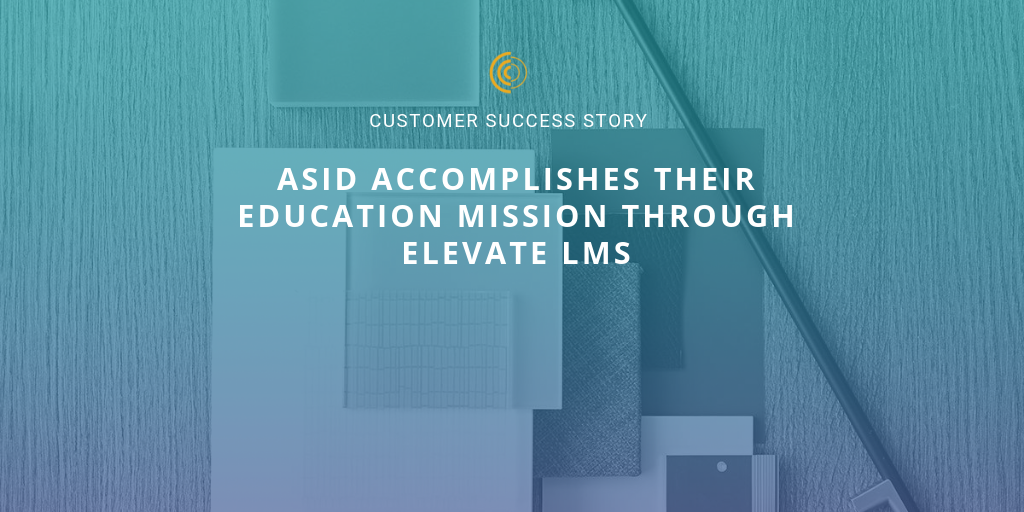
by Rachel Blevins | Aug 12, 2019 | Blog, Customer Stories, Education
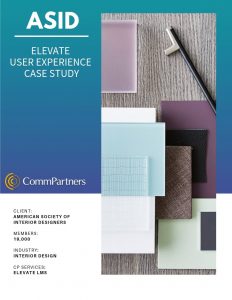
Read the Full Story |
Commpartners had the opportunity to speak with the American Society of Interior Design about their success with implementing CommPartners Elevate LMS. As an organization who focuses on the design and aesthetic of beautiful interiors, it was important that their platform encompassed a clean and cohesive design to match their brand. This led to one of their main deciding factors to be the ability to work with the CP team to create a fully customized site to their specifications.
ASID identified a number of core requirements they wanted to address with a new LMS, stated in the bullets below. Click the case study to learn how they overcame these challenges by utilizing Elevate LMS.
- Provide a seamless user experience where the LMS is fully integrated with ASID’s web presence and database
- Match ASID’s mission by focusing on design of attractive imagery and navigation elements that allow learners to easily access their content
- Ensure an engaging mobile experience
- Support learners’ desire for well conceived and developed on demand content.
|
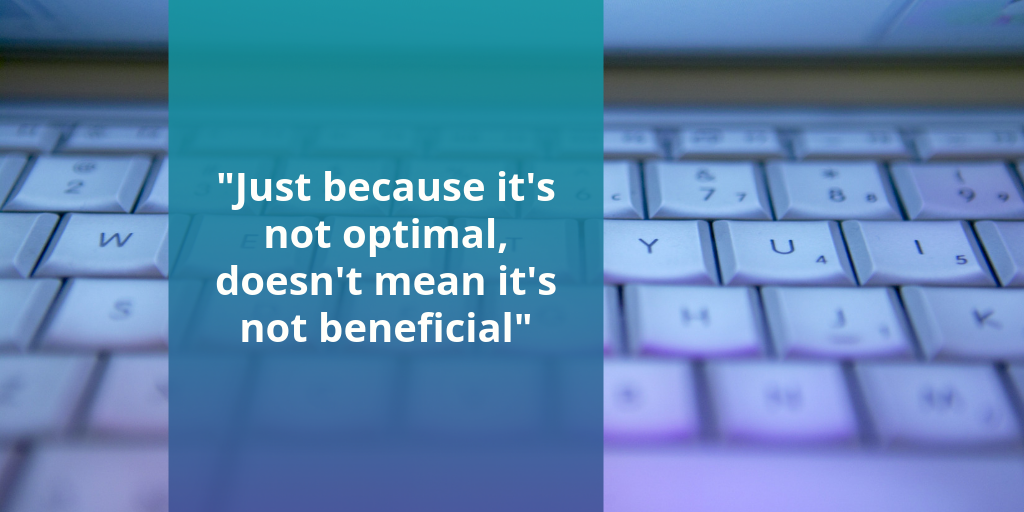
by Rachel Blevins | Jul 30, 2019 | Blog, Education
I’m a big fan of the author James Clear who writes about the formation of habits. I believe (good!) habits are an important element of success (I’ve written about it before.)
In a recent blog post, Clear wrote: “Just because it’s not optimal, doesn’t mean it’s not beneficial.” Read another way, this is the old adage of don’t let the perfect become the enemy of the good. Or don’t let perfection be your target, because you’ll always fail.
I see this very commonly when discussing the integration of systems with clients (e.g., AMS and LMS). The optimal situation is a real-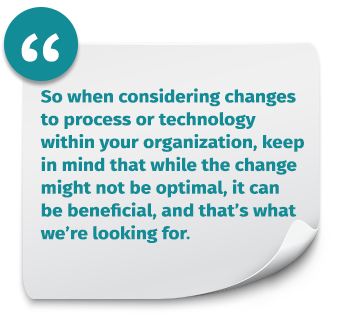 time, two-way integration between the two systems so that data is shared immediately.
time, two-way integration between the two systems so that data is shared immediately.
But this often proves to be very time-consuming and expensive to develop (and sometimes can’t be developed!). So rather than a two-way, real-time integration we opt for a two-way passing of data on a schedule (e.g., once per day). Optimal? No. Beneficial? Absolutely.
So when considering changes to process or technology within your organization, keep in mind that while the change might not be optimal, it can be beneficial, and that’s what we’re looking for.
This guest blog post/article first appeared at www.effectivedatabase.com and is repurposed with permission.

Wes Trochlil is a published author on data management in the association market. He helps organizations move data management from a cost center to a revenue generator.
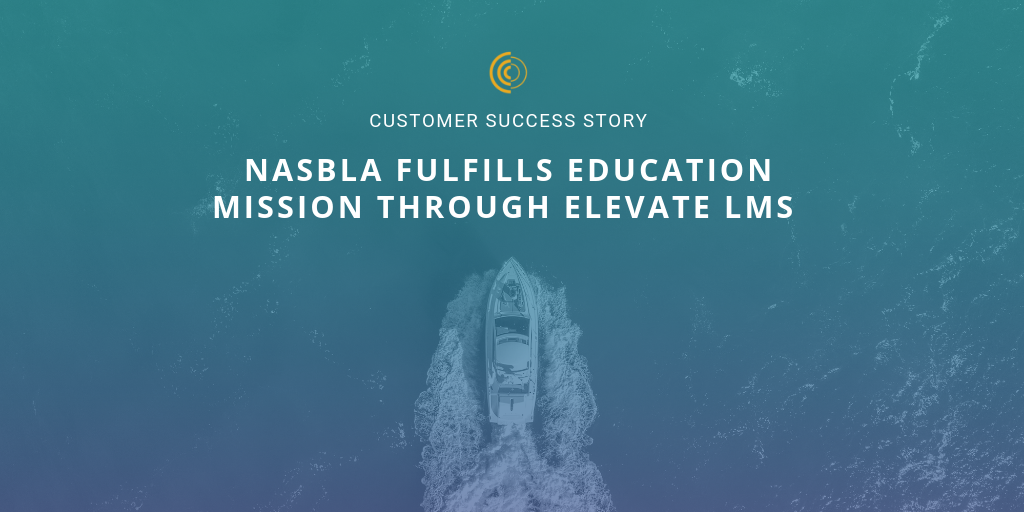
by Rachel Blevins | Jun 20, 2019 | Customer Stories
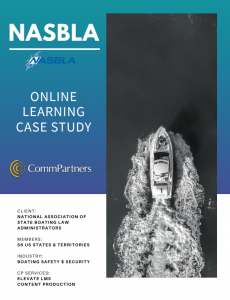
Read the Full Story |
Commpartners had the opportunity this past week to speak with Ron Sarver, Chief, Knowledge & Learning Management Systems Officer of the National Association of State Boating Law Administers. Ron shared his plan to move beyond place based events, to the creation of a highly engaging online learning community through Elevate LMS. Ron stated that he and others from NASBLA feel online learning provides the best opportunity to engage their entire community through knowledge. An overarching goal is to use the Elevate to transcend membership and attract an entire industry that cares about boating safety and security.
NASBLA identified a number of core challenges they wanted to address with a new LMS, stated in the bullets below. Click the case study to learn how they overcame these challenges by utilizing Elevate LMS.
- Leverage and expand the impact of in-person conferences
- Support their community with greater access to compelling content
- Structure learning as a continuous or fluid process
|
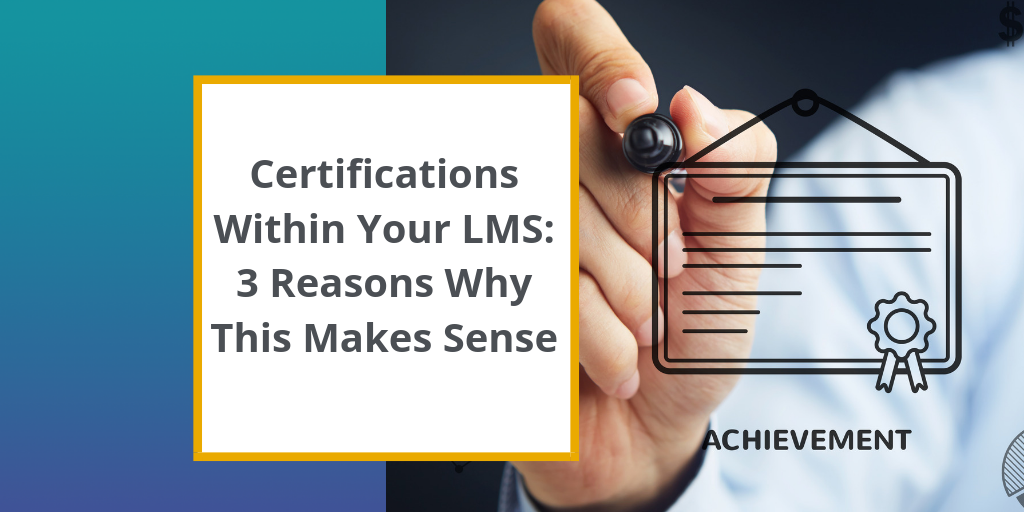
by Rachel Blevins | Jun 13, 2019 | Blog
In the past several years, we have witnessed significant development and expansion in LMS offerings. Today’s platforms provide a wide range of contextual education experiences including formal or curriculum-based education, informal learning, live events, and social learning. Many of our communities value the opportunity to have a single, central repository that provides different leaning options and formats.
With so much invested in these online learning portals, it makes sense to continue to build and expand on what an LMS is able to provide. Including certifications in your online education strategy helps create a more impactful and recognized standard of achievement. Certifications are the ideal component to augment and extend the value and the investment you have made in ensuring your LMS becomes a success. In addition, certifications enable education program providers to more effectively validate and reward achievement that is recognized by one’s peers and potential employers. Essentially, offering certifications within your organizations LMS can extend the platform’s value and help build on your established success.
We have identified three key benefits of offering certification programs within your LMS:
- Create of a Pathway towards Achievement
Certification provides organizations the ability to configure a predetermined curriculum or pathway that serves as a navigator or blueprint towards a greater goal. This added enhancement provides learners a sense of purpose as they can connect their work in the LMS to an overall strategic purpose and mission. Certifications and features of the LMS are an ideal match to present content, validate progress and award achievement. Gaps in knowledge are easily identified which helps pinpoint areas for improvement.
- Leverage Your LMS more effectively
Being certified in something that typically translates into one’s expertise within a specific area of study or work. It is understood that if you are going to be certified you will typically need to invest a significant amount of time and money to reach your goal. Given this commitment, it only makes sense to leverage these achievements within your current LMS platform by offering certification programs to your learners. The days of sending learners to a third party site are coming to an end, and now it’s easier than ever to utilize your investment right within your LMS to validate course content and testing components. Bringing these participants to the LMS leverages your investment, increases traffic and avails learners to other opportunities to engage content experts and peers.
- Streamline Processes
There is a good chance your LMS is integrated with your ecosystem of applications. You may already have data reporting in place to transfer results from education activities to a third party database or AMS. Offering certifications within your LMS can piggyback on this integration and allow a seamless reporting of results without additional programming.
If you offer or plan to offer certifications to your community, consider an LMS platform that had a feature that supports these programs along with other education offerings.
To learn more about Elevate LMS and CommPartners Certification Module, please contact Meghan Gowen at mgowen@commpartner.com.












